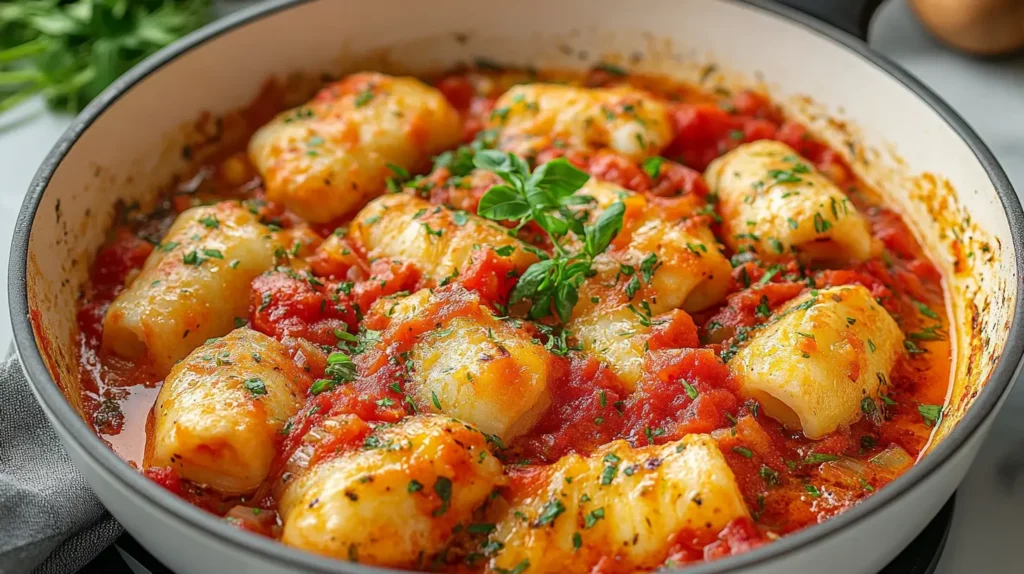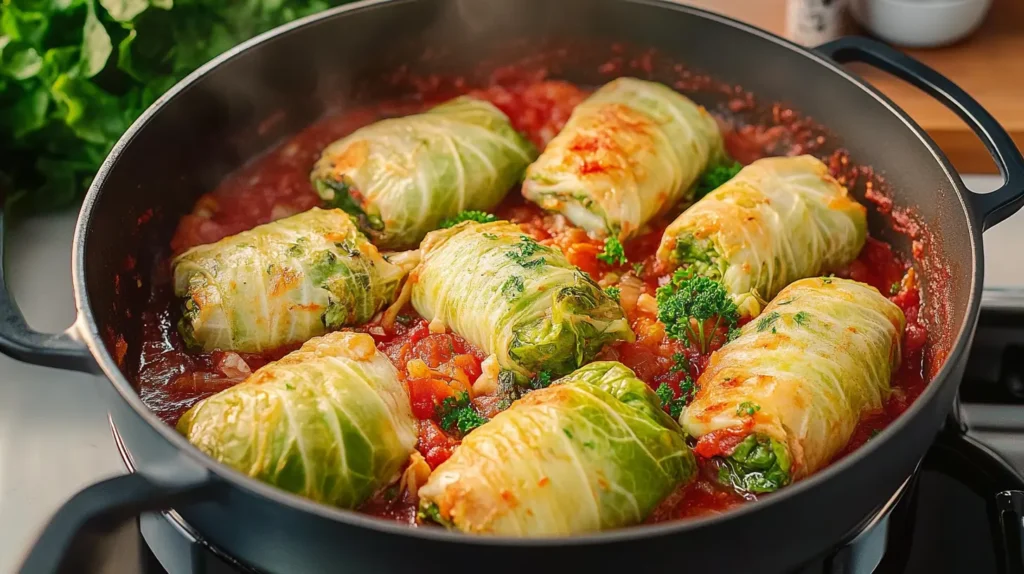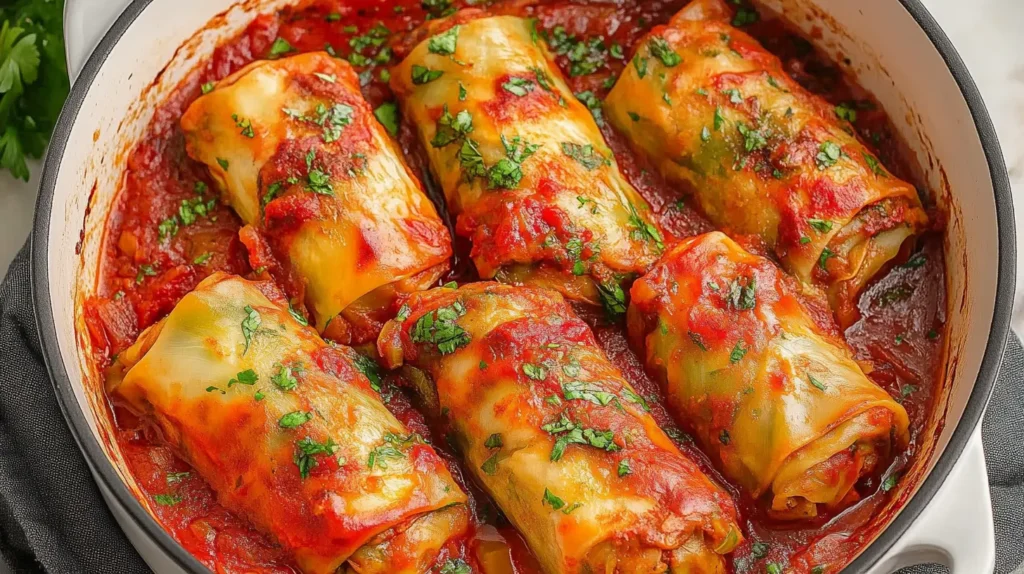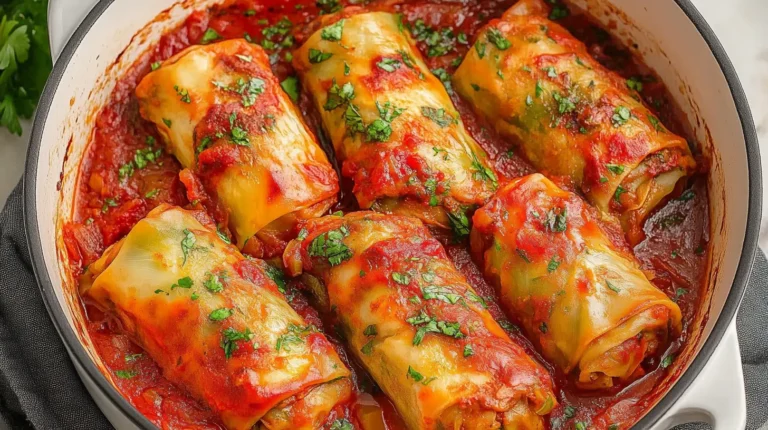
Overview of Polish Cabbage Rolls
As we dive deeper into the world of cabbage rolls, we find ourselves moving to Poland, where the dish takes on a unique cultural and culinary identity. Known as Gołąbki, which translates to “little doves,” Polish cabbage rolls bring warmth, comfort, and a sense of nostalgia to many families. I fondly remember my first experience with these delicious parcels at a family gathering, where every bite transported me to my grandmother’s cozy kitchen.
in this blog, I provide free recipes that anyone can try, whether you’re a beginner or a seasoned home cook. I believe that cooking should be fun, rewarding, and most importantly, delicious! So, join me as I share my favorite dishes, tips, and kitchen experiments.You may like trendy recipes like Some muffins for breakfast , or just explore the recipe Menu. Let’s cook up something amazing together!
Ingredients Used in Polish Cabbage Rolls
The beauty of Polish cabbage rolls lies in their simple yet wholesome ingredients. While many might think of the dish as a just-meat-and-rice combination, the variations are endless! Here’s a table showcasing the core ingredients commonly found in a traditional Polish Gołąbki:
| Ingredient | Description |
|---|---|
| Cabbage | A large head of green cabbage, typically 3 pounds or more. |
| Ground Meat | Most commonly pork, beef, or a mixture of both. |
| Rice | Short or medium grain white rice, cooked until just underdone. |
| Onion | Finely chopped; sautéed to bring out sweetness. |
| Garlic | Minced or finely chopped, for an aromatic kick. |
| Tomato Sauce | Often a rich tomato sauce or canned tomatoes, used for baking. |
| Spices | Salt, pepper, and sometimes paprika or dill for added flavor. |
| Mushrooms | Sautéed mushrooms add depth and umami to the filling. |
In addition to these staples, some families incorporate unique touches such as bacon bits or herbs, adding a personalized flair to the dish. Growing up, my aunt would sneak in a hint of smoked paprika to create a comforting warmth that would linger in every bite.
Traditional Polish Cabbage Roll Preparation Methods
Now, let’s roll up our sleeves for the preparation of Polish cabbage rolls! While it may seem like a lengthy process, each step is filled with love, laughter, and the sweet anticipation of the end result. Here’s how to make Gołąbki the traditional way:
- Preparing the Cabbage:First, we need to soften the cabbage leaves. I still remember the day my grandmother handed me the hefty head of cabbage—she would always choose the freshest one from the market.
- Place the whole head of cabbage in a pot of boiling water.
- Cook for about 15 minutes, gently peeling off the softened leaves as they wilt.
- Set these aside to cool.
- Making the Filling:While the cabbage cooks, this is the perfect time to make the filling. The aroma in the kitchen is incredibly inviting!
- In a skillet, sauté chopped onions in a bit of oil until they are translucent.
- Cook rice in a separate pot, using a mix of water and any leftover broth for flavor.
- Combine the cooked rice, sautéed onions, ground meat, salt, pepper, and any additional spices you desire. That’s when the magic happens—as you mix everything, the flavors naturally meld together.
- Assembling the Rolls:Now comes the fun part—assembling the cabbage rolls!
- Take a cabbage leaf and place a generous dollop of the filling at the center.
- Fold in the sides and roll from the stem to the tip, creating a snug little parcel.
- Arrange the finished rolls seam-side down in a large baking dish.
- Cooking the Rolls:It’s time for these rolls to transform into a comforting meal!
- Pour a rich tomato sauce over the arranged cabbage rolls.
- Cover the dish with foil and bake it in a preheated oven at 350°F (175°C) for about an hour.
- The anticipation is palpable in my household during this time— the smell wafting through the air serves as an invitation for everyone to gather around the table.
- Serving:Once fully cooked, serve the Gołąbki hot, garnished with fresh herbs or accompanied by a dollop of sour cream.
- This hearty meal is perfect for winter gatherings, family dinners, or even festive celebrations. I cherish the moments spent with loved ones sharing stories and memories over plates of Gołąbki.
A Labor of Love
As I recall my childhood, the making of Polish cabbage rolls was always a family affair. I remember my cousins gathering around the table, competing for the title of “best roll maker.” While making Gołąbki does require a bit of time and effort, it’s a cherished experience that creates not just a meal but a sense of connection and tradition.
In preparing Polish cabbage rolls, we discover that food is not just about filling our stomachs; it’s about filling our lives with shared stories and timeless memories. As we take a bite of these warm parcels, we experience the essence of Polish culture—a blend of generations, flavors, and love that warms the heart and nourishes the soul.
Next, we’ll venture into Ukraine, exploring the world of Ukrainian cabbage rolls and how they compare with their Polish counterparts, unearthing the delightful nuances of this beloved dish!
Overview of Ukrainian Cabbage Rolls
Transitioning from Polish to Ukrainian cuisine feels like stepping into a kitchen filled with love, flavors, and rich traditions. In Ukraine, cabbage rolls, or Holubtsi, are more than just a meal; they’re a symbol of warmth, comfort, and family gatherings. These stuffed cabbage rolls often evoke fond memories, reminding me of cozy holidays spent with my grandmother, who would amaze us with her culinary skills.
Ingredients Used in Ukrainian Cabbage Rolls
Ukrainian Holubtsi showcases a delightful medley of ingredients that harmonize beautifully. While the basics may resemble those of Polish cabbage rolls, subtle variations create a distinct identity for each dish. Here’s a closer look at the primary ingredients typically found in Ukrainian cabbage rolls:

| Ingredient | Description |
|---|---|
| Cabbage | A large head of green cabbage (approximately 3-4 pounds) is typically used. |
| Ground Meat | Often a blend of pork and beef, but variations can also include chicken or turkey. |
| Rice | Medium grain rice, cooked to ensure perfect texture. |
| Onion | Finely chopped; sautéed to enhance flavor. |
| Garlic | Minced; adds a depth of aroma and taste. |
| Dried Mushrooms | Often used for added umami flavor, providing a rich depth. |
| Tomato Sauce | Typically a tomato-based sauce that serves as a base for baking. |
| Barberries | A unique addition in some recipes, lending a tart flavor. |
| Spices | Salt, pepper, and fresh herbs like dill or parsley. |
I remember visiting a local Ukrainian market and being captivated by the array of fresh vegetables and ingredients, all perfect for making Holubtsi. My grandmother would choose the ripest tomatoes and the freshest cabbage, ensuring the best results for her rolls.
Traditional Ukrainian Cabbage Roll Preparation Methods
Preparing Holubtsi is a cherished process, one that brings family together in the kitchen. Although it may take some time, each step is filled with affection and nostalgia. Here’s how to create authentic Ukrainian cabbage rolls at home:
- Selecting and Preparing the Cabbage:The first step is to choose a large head of green cabbage.
- Bring a large pot of water to a boil and carefully add the whole cabbage head, simmering it for about 15-20 minutes until the outer leaves soften.
- Using tongs, gently peel off the softened leaves and set them aside to cool.
- Making the Filling:While the cabbage cooks, the filling can come together! This is where the kitchen fills with enticing aromas.
- In a skillet, heat oil and sauté chopped onions until they turn a translucent golden color.
- Combine the sautéed onions with ground meat, cooked rice, minced garlic, and any spices you desire.
- Add dried mushrooms (rehydrated in boiling water) to enhance the flavor profile.
- Assembling the Rolls:Now comes the fun part—assembling the Holubtsi!
- Take a softened cabbage leaf and place a spoonful of the filling at the base.
- Fold in the sides and roll it up, tucking the filling securely inside. Repeat this process until all the filling is used.
- Arrange the prepared rolls seam-side down in a large baking dish.
- Baking and Cooking the Rolls:It’s time for the Holubtsi to meld together in the oven.
- Pour a generous amount of tomato sauce over the arranged rolls, adding a splash of water to avoid direct burning.
- Cover the dish with foil and bake at 350°F (175°C) for about 60-75 minutes, allowing the flavors to mix beautifully.
- Serving and Enjoying:Once baked, serve the Holubtsi hot, topped with dollops of sour cream or a sprinkle of fresh dill.
- In my family, we often serve them alongside crusty bread to soak up the delicious tomato sauce. It creates a hearty meal that’s perfect for family gatherings.
A Tradition of Warmth
Growing up, my favorite part of the Holubtsi-making process wasn’t just the delicious end product; it was the time spent bonding with family as we rolled the leaves and added our unique touches. Each roll represented love and care, encapsulated in vibrant cabbage leaves.
In Ukrainian kitchens, making Holubtsi often extends beyond a simple recipe—it’s an event that invites everyone to join in. Whether it’s a traditional holiday meal or a weekend gathering, these cabbage rolls embody the warmth of Ukrainian culture.
Next, we’ll transition into a comparison between Polish and Ukrainian cabbage rolls, exploring the delightful similarities and subtle differences that make each version special in its own right!
Comparison of Polish and Ukrainian Cabbage Rolls
Having explored the distinctive flavors and traditions behind Polish and Ukrainian cabbage rolls, we can now delve into the delightful differences that set these two versions apart. While both are cherished in their respective cultures, they each have unique characteristics that reflect regional ingredients and cooking methods. As I savor each bite of these beloved dishes, I can’t help but admire their intricate similarities and subtle differences that tell a story of culinary heritage.
Differences in Filling Ingredients
When it comes to the filling of cabbage rolls, both Polish and Ukrainian variations start with a base of meat and rice. However, there are notable differences in the additional ingredients used, which lend each dish its unique flavor profile.
Polish Cabbage Rolls (Gołąbki):
- Meat Choices: Traditionally, Polish cabbage rolls often feature a combination of pork and beef. Some recipes may even call for turkey or chicken.
- Filler Additions: Besides meat and rice, these rolls frequently include mushrooms, particularly when honoring older recipes or using foraged varieties. The mushrooms add an earthy, umami flavor that deepens the dish.
- Grains: Historically, Polish cabbage rolls did not always rely on rice. Some older recipes favored buckwheat as the grain of choice, which is particularly common in certain regions of Poland.
Ukrainian Cabbage Rolls (Holubtsi):
- Meat Varieties: Ukrainian versions also commonly use pork and beef, but they often incorporate a unique ingredient found in many Ukrainian recipes—barberries. This adds a surprising sour note that beautifully contrasts with the savory filling.
- Vegetarian Options: A popular alternative among some Ukrainians, especially during fasting periods, is to create a vegetarian version with mushrooms or buckwheat. This version retains a rich flavor without the meat, showcasing the versatility of Holubtsi.
- Herbs and Spices: Holubtsi frequently call for a variety of herbs, enhancing the filling’s aromatic quality. Fresh dill or parsley may be included, giving the dish a bright freshness.
Growing up, my Polish friend often prepared Gołąbki for family gatherings, while my Ukrainian neighbor delighted us with her grandmother’s Holubtsi, which were always accompanied by a side of sour cream. The flavors of both dishes were comforting, and I began to understand the subtleties that made each one special in its own right.
Variations in Cooking Techniques and Spices Used

While both Polish and Ukrainian cabbage rolls share a similar preparation method—stuffing cabbage leaves with savory fillings and baking them in sauce—small variations in cooking techniques set them apart.
Polish Cooking Techniques:
- Baking in Tomato Sauce: Gołąbki are typically baked in a rich, often sweet tomato sauce that balances the savory filling. The dish develops a delightful simmering flavor in the oven.
- Finishing Touches: After baking, these rolls are often served with a creamy dollop of soured cream, which rounds out each bite with tangy goodness.
- Slow Cooking: Many Polish families enjoy the traditional slow-cooked approach, simulating a heartwarming, comforting flavor reminiscent of days gone by.
Ukrainian Cooking Techniques:
- Slow Cooking with Variants: Holubtsi can also be made in a slow cooker for maximum tenderness, but they are more commonly baked in an oven with tomato sauce that holds the flavors beautifully.
- Spice Profiles: Ukrainians love to enhance their rolls with fresh herb blends. Dill is used prolifically, sometimes sprinkled on top just before serving, creating an aromatic herbal note.
- Flavoring Sauces: Besides tomato sauce, some variations may see Holubtsi drizzled with a mix of sour cream and dill sauce to provide extra seasoning and creaminess.
Reflecting on my culinary adventures, I recall a cozy dinner at my Ukrainian friend’s house, where the rich aroma of Holubtsi filled the air. She explained the importance of the fresh dill topping, which I learned made a world of difference in highlighting the mushroom flavors.
Wrapping Up the Comparison
As we wrap up our exploration of Polish and Ukrainian cabbage rolls, it’s evident that while these dishes share a common ancestry and ingredients, their individual flavors and techniques tell a story of cultural significance and culinary depth.
- Cultural Heritage: Both dishes symbolize warmth and hospitality—cooking them invokes family gatherings, comfort food moments, and cherished traditions. My memories of sharing treasured recipes with both cultures gave me a unique perspective on the importance of food in fostering connections.
- Personal Touch: Each family’s recipe reflects their love and care and can vary from household to household, just as my grandmother’s method differed from my friends’.
Whether it’s the earthy depth of Polish Gołąbki or the bright tang of Ukrainian Holubtsi, both dishes promise to delight our palates. As these remarkable dishes continue to thrive, they weave a rich tapestry of history, culture, and family memories that connects us all.
In our next section, we’ll dive into the cultural significance of these beloved cabbage rolls in both Polish and Ukrainian traditions!
Cultural Significance of Cabbage Rolls in Poland and Ukraine
As we delve into the heart of Eastern European cuisine, it’s impossible not to highlight the cultural significance of cabbage rolls. In Poland, these delightful parcels, known as Gołąbki, are more than just food; they represent tradition, community, and a culinary connection to the past. Through my personal experiences and observations, I have witnessed the power of food to bring people together, transcending generations.
Role of Cabbage Rolls in Polish Cuisine
Cabbage rolls hold a special place in Polish culinary tradition, serving as a comfort food that invokes cherished memories. When I think back to family gatherings, the smell of baking Gołąbki filled the air, signaling warmth and togetherness. This dish goes beyond simple ingredients; it embodies a shared history that resonates deeply in Polish culture.
A Symbol of Tradition
- Roots in History Cabbage rolls in Poland can trace their roots back to the 19th century, influenced by surrounding countries such as Ukraine. These stuffed cabbage leaves were often filled with locally available ingredients, showcasing the adaptability of Polish cuisine. Historical figures often dined on variations of this dish, solidifying its place in Polish culinary heritage.
- Celebrations and RitualsPolish cabbage rolls often find their way to the table during significant celebrations and family gatherings.
- Weddings and Holidays: Many families enjoy making Gołąbki during holidays like Christmas and Easter. They often take center stage during big family dinners, making these occasions feel more festive.
- Family Reunions: My own family tradition emphasizes making Gołąbki as part of our reunions. The preparation usually involves multiple generations, with stories being shared as we roll the leaves and fill them with the savory mixture of meat and rice.
The Comfort of Home Cooking
Cabbage rolls represent the essence of home cooking in Polish culture. The preparation is not just an act of making food but an opportunity to bond with loved ones, passing down recipes and cooking techniques across generations.
- In the Kitchen Together: As a child, I remember my grandmother teaching me how to prepare Gołąbki. The kitchen would turn into a flurry of activity, filled with laughter and the sound of pots clanging. We used her old wooden table, a center point for our culinary adventures.
- Regional Variations: Even though Gołąbki have a standard filling of meat and rice, each region in Poland has its own twist, showcasing local ingredients. Some might incorporate mushrooms for added depth, while others might use barley, reflecting the agricultural diversity across the country.
A Unifying Dish
Polish cabbage rolls serve as a unifying dish that crosses borders, connecting not only families but also communities. My encounters with friends from various Polish backgrounds taught me how Gołąbki might be prepared differently, yet the love behind them remains consistent.
- Bridging Generations: For many, the act of rolling cabbage leaves brings forth memories of their grandparents and ancestors, creating a culinary bridge to the past.
- Community Gatherings: Polish festivals often feature Gołąbki, where families gather to share meals and celebrate their heritage. The comforting nature of this dish encourages mingling and storytelling, truly embodying the spirit of community.
Nutritional Comfort
Cabbage rolls are a wholesome meal that reflects Polish agricultural practices. The ingredients are often locally sourced and hold significant nutritional value, showcasing a connection to the land.
- Cabbage: Packed with vitamins and minerals, cabbage is a staple vegetable that symbolizes nourishment and prosperity.
- Meat and Grains: The inclusion of ground meat and rice offers a balanced meal, satisfying hunger with flavors that comfort the soul.
This connection to healthful living is something that has always resonated with me; I see how dishes like Gołąbki celebrate not only taste but also nutrition.
The Modern-day Connection
In today’s fast-paced life, many Poles still hold on to the tradition of making Gołąbki, often using modern conveniences while keeping the essence of the dish intact.
- Family Meal Prep: Busy families might opt for a simplified recipe but still gather together to enjoy this beloved dish.
- Freezing for Convenience: Some cooks batch-prepare these rolls and freeze them, making it easy to serve a taste of tradition without the hassle during hectic weekends.
Reflecting on these practices, I find that no matter how simplified the preparation has become, the underlying sentiment remains; it’s about family, love, and the joy of creating something together.
Conclusion
In Poland, cabbage rolls aren’t just a meal; they are rich in history and cultural significance. As I think about my experiences with Gołąbki, it’s clear that this dish represents the very essence of Polish hospitality, family values, and culinary tradition. The comforting taste of those tender cabbage leaves filled with savory goodness will always remind me of home, and it is this connection that makes cabbage rolls profoundly meaningful in Polish cuisine.
As we continue to explore the culinary significance of cabbage rolls, let’s turn our attention to how they play an influential role in Ukrainian traditions, highlighting the shared yet distinct cultural threads that bind these two nations together.
Role of Cabbage Rolls in Ukrainian Cuisine
As we transition from exploring the significance of cabbage rolls in Polish culture, let’s now immerse ourselves in the heartwarming world of Ukrainian cuisine, where cabbage rolls, known as Holubtsi, hold a cherished place. These delicious parcels go beyond being just a meal; they signify tradition, community, and the warmth of Ukrainian hospitality. In my experience, the comforting aroma of Holubtsi paired with family tales creates an unforgettable backdrop for gatherings.
A Ukrainian Tradition with Deep Roots
Cabbage rolls have become a hallmark of Ukrainian culinary tradition. Growing up in a Ukrainian household, I fondly remember gatherings where Holubtsi graced the table, served with generous portions of sour cream and sprigs of fresh dill. It’s fascinating to learn that this dish dates back centuries, rooted in the agricultural practices of the region.
- Historical Significance: The origins of Holubtsi can be traced back to Ukrainian aristocracy, where influencers adapted stuffed cabbage using pigeon as the filling. As recipes filtered down through generations, locals began using more accessible ingredients, solidifying Holubtsi into the homes of many Ukrainians.
- Symbol of Comfort: Holubtsi evoke feelings of home for many Ukrainians. The act of making these rolls together not only fosters togetherness but ensures the preservation of family recipes that define culinary identity.
The emotional connection to Holubtsi reminds me of my grandmother’s kitchen, filled with laughter and chatter as we all gathered to make this beloved dish. The rolling of cabbage leaves felt like bonding time, a part of the ritual that was as significant as enjoying the meal itself.
The Ingredients That Bind Us
Central to the allure of Ukrainian cabbage rolls is the careful selection of ingredients that reflect the nation’s agricultural bounty.
| Ingredient | Purpose |
|---|---|
| Cabbage | Acts as the vessel for the filling, providing texture and nutrition. |
| Pork and Rice | The two core ingredients that make the hearty filling, offering both richness and sustenance. |
| Onion and Garlic | Elevate the flavors, adding aromatic depth to the rolls. |
| Tomato Sauce | Envelops the rolls, adding acidity and balance to the savory filling. |
| Barberries | A distinctive ingredient that imparts tang, reflecting traditional Ukrainian flavors. |
I remember watching my grandmother meticulously prepare the filling, always ensuring the proportions were just right. The mixture of savory pork, aromatic herbs, and sweet onions became the signature taste of her Holubtsi.
Celebration of Community and Heritage
Cabbage rolls in Ukraine are not merely food; they are a celebration of togetherness, often appearing during significant family occasions and holidays.
- Holidays and Gatherings: Holubtsi are a traditional dish served during Christmas, Easter, and weddings. Families unite in the kitchen to prepare large batches, storing leftovers to enjoy throughout the festive season.
- Cultural Identity: Each family often adds their unique twist to Holubtsi based on regional variations or personal preferences. For instance, some might use buckwheat as a filling during Lenten periods, showcasing the cultural flexibility inherent within the recipe.
I still recall joining my extended family during Christmas, where Holubtsi were part of the traditional twelve dishes served on Christmas Eve, symbolizing abundance and hospitality. The joy of sharing such meals fosters stronger family ties and cultural continuity.
Cooking Techniques Reflecting Tradition
While making Holubtsi may involve multiple steps, the process is straightforward and often a communal activity. Here’s how it’s typically done:
- Boiling the Cabbage: The first step is to soften the cabbage leaves. Many cooks simply blanch the entire head of cabbage, then carefully peel away the tender leaves.
- Preparing the Filling: Ground pork is mixed with pre-cooked rice, chopped onion, and garlic, along with spices such as salt and pepper.
- Rolling the Leaves: Each leaf is filled with the meat mixture, rolled tightly, and then placed in a baking dish.
- Baking in Tomato Sauce: The rolls are covered with a rich tomato sauce and baked, allowing the flavors to meld beautifully.
This method carries sentimental value, as it has been passed down for generations. Each family member adds their flair—whether that’s the twist of a sprinkle of dill or how they prefer to incorporate spices into the tomato sauce.
Holubtsi as Hearty Comfort Food
In a world where quick meals are often prioritized, Holubtsi stand out as a hearty comfort food that requires time and love to prepare. I’ve often found solace in this dish, especially during cold winter months.
- Freezing for Future Enjoyment: Holubtsi can be made in bulk and frozen, making them accessible for busy days. The very act of unearthing these rolls from the freezer brings a sense of familiarity and comfort.
- Sharing the Love: I’ve often gifted frozen Holubtsi to friends and neighbors, a gesture that embodies the very spirit of Ukraine—sharing traditional meals to create bonds within the community.
Whether served at celebrations or as a comforting weekday meal, Holubtsi encapsulate not just flavors but stories, histories, and family traditions, making them a true staple in Ukrainian cuisine.
As we wrap up our exploration of Holubtsi’s significance in Ukrainian culture, it’s clear that cabbage rolls are much more than a collective meal; they represent heritage, warmth, and connection among loved ones. In our next segment, we’ll delve into how these traditions resonate beyond the dinner table, influencing both communities and individual identities in Ukraine.
Print
What is the difference between Polish and Ukrainian cabbage rolls?
Traditional Polish cabbage rolls, known as Gołąbki, are a comforting dish made with tender cabbage leaves stuffed with a savory meat and rice filling, then baked in a rich tomato sauce.
- Total Time: 1 hour 30 min
- Yield: 6 servings 1x
Ingredients
- 1 large head cabbage
- 1 lb ground meat (pork, beef, or a mix)
- 1 cup cooked white rice
- 1 onion, finely chopped
- 2 cloves garlic, minced
- 2 cups tomato sauce
- 1 tsp salt
- ½ tsp black pepper
- ½ tsp paprika (optional)
- 1 tbsp chopped dill (optional)
- 2 tbsp vegetable oil
Instructions
- Bring a large pot of water to a boil. Carefully place the whole cabbage head in the water and simmer for about 15 minutes. Gently peel off the softened leaves and set aside to cool.
- In a skillet, heat oil and sauté the chopped onions until they turn translucent. Add the minced garlic and cook for another minute.
- In a large bowl, combine the cooked rice, sautéed onions, garlic, ground meat, salt, black pepper, and paprika (if using). Mix well to incorporate all the flavors.
- Take a cabbage leaf and place a generous spoonful of the filling at the center. Fold in the sides and roll tightly from the stem to the tip.
- Arrange the cabbage rolls seam-side down in a large baking dish.
- Pour the tomato sauce over the rolls, covering them evenly.
- Cover the dish with foil and bake in a preheated oven at 350°F (175°C) for about 1 hour.
- Serve hot, garnished with fresh dill or a dollop of sour cream.
Notes
For extra flavor, add sautéed mushrooms to the filling. Leftover cabbage rolls store well and can be frozen for future meals.
- Prep Time: 30min
- Cook Time: 60min
- Category: Calories: 320 kcal
- Cuisine: Polish
